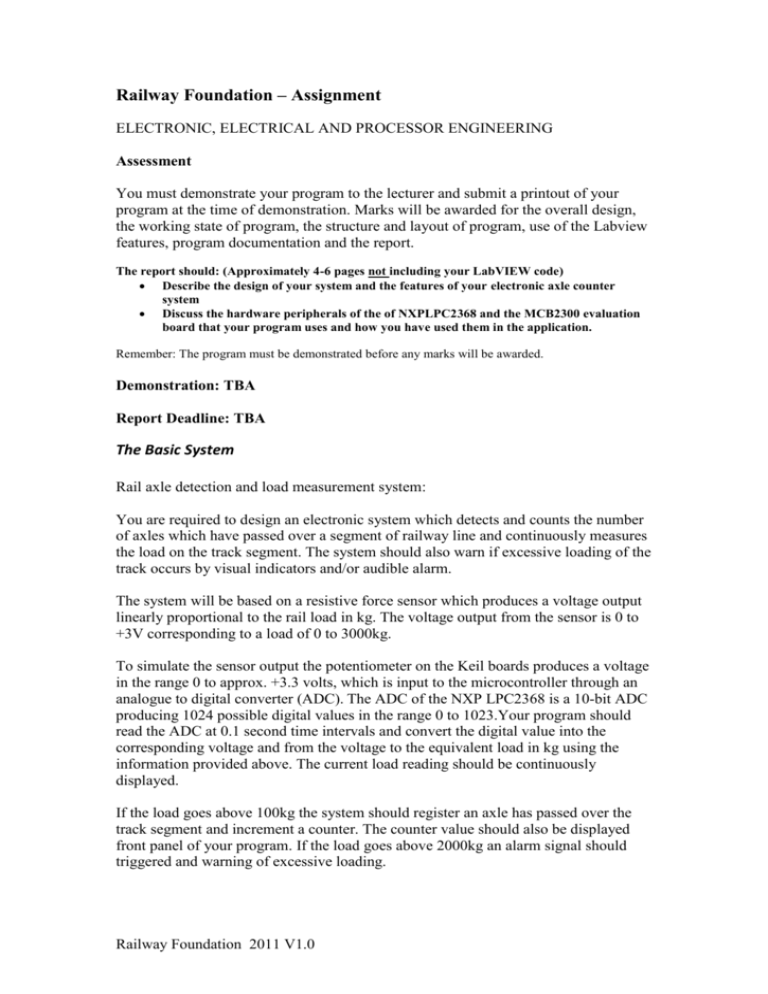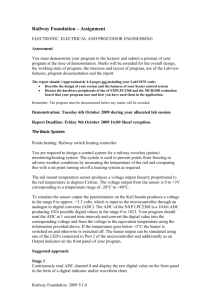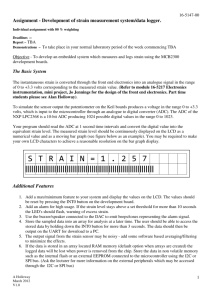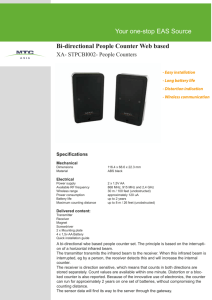Railway Foundation * Laboratory Assessment
advertisement

Railway Foundation – Assignment ELECTRONIC, ELECTRICAL AND PROCESSOR ENGINEERING Assessment You must demonstrate your program to the lecturer and submit a printout of your program at the time of demonstration. Marks will be awarded for the overall design, the working state of program, the structure and layout of program, use of the Labview features, program documentation and the report. The report should: (Approximately 4-6 pages not including your LabVIEW code) Describe the design of your system and the features of your electronic axle counter system Discuss the hardware peripherals of the of NXPLPC2368 and the MCB2300 evaluation board that your program uses and how you have used them in the application. Remember: The program must be demonstrated before any marks will be awarded. Demonstration: TBA Report Deadline: TBA The Basic System Rail axle detection and load measurement system: You are required to design an electronic system which detects and counts the number of axles which have passed over a segment of railway line and continuously measures the load on the track segment. The system should also warn if excessive loading of the track occurs by visual indicators and/or audible alarm. The system will be based on a resistive force sensor which produces a voltage output linearly proportional to the rail load in kg. The voltage output from the sensor is 0 to +3V corresponding to a load of 0 to 3000kg. To simulate the sensor output the potentiometer on the Keil boards produces a voltage in the range 0 to approx. +3.3 volts, which is input to the microcontroller through an analogue to digital converter (ADC). The ADC of the NXP LPC2368 is a 10-bit ADC producing 1024 possible digital values in the range 0 to 1023.Your program should read the ADC at 0.1 second time intervals and convert the digital value into the corresponding voltage and from the voltage to the equivalent load in kg using the information provided above. The current load reading should be continuously displayed. If the load goes above 100kg the system should register an axle has passed over the track segment and increment a counter. The counter value should also be displayed front panel of your program. If the load goes above 2000kg an alarm signal should triggered and warning of excessive loading. Railway Foundation 2011 V1.0 Suggested approach Stage 1 Continuously read ADC channel 0 and display the raw digital value on the front panel in the form of a digital indicator and/or waveform chart. Stage 2 Add a delay to the system so the ADC is sampled every 0.1s. Convert the raw ADC value into corresponding voltage and from the voltage to the equivalent load in kg and display the load using a digital indicator and/or waveform chart. Stage 3 Compare the load value to the set point (100kg) and depending on the case (>100kg increment a counter) and (<100kg do nothing). Display the counter value on the front panel in the form of a digital indicator. Stage 4 If the load value is greater than 2000kg an alarm should be triggered. Initially this should be in the form of an LED (s) which illuminates. Producing a basic working system described above and a report containing a clearly structured block diagram and associated front panel display will be sufficient for a pass mark of 40%. Stage 5 (+15%) If the train passes over the track segment slowly many increments of the counter may be observed. Modify your program to only increment the counter after each complete cycle - the value must first go above the 100kg set and then go below 100kg before the counter is incremented. Modify the previous program to make use of the LCD screen on the MCB2300 board. The LCD should display the current load and the status off the alarm. Add a control to the front panel which allows the set point for the load alarm to be adjusted. For additional marks some of the following features may be added to the basic system and documented in your report. 1. [+5%] Use the Push button (INT0) connected to port2 bit 10 to select if the load is displayed in kilograms or Pounds. 2. [+5%] Add a max/minimum feature to your system. The values should be reset by a control switch on the Front Panel of the VI. 3. [+5%] If the push button is held for longer than 3s the counter value should be reset. 4. [+5%] Use the buzzer/speaker connected to the DAC to emit beeps/tones representing the alarm signal. 5. [+10%] In a previous version of the system it was found that when the actual load value was near the set point load the axle counter was being incremented Railway Foundation 2011 V1.0 many times during a single axle pass giving an invalid reading. A solution to this problem would be desirable. 6. [+15%] Add your own innovative features! Railway Foundation 2011 V1.0 Useful Information. The following is a brief list of some of the LPC2368 & I/O Application board features: NXP LPC2368 Microcontroller ARM7TDMI-S based high-performance 32-bit RISC Microcontroller 58 Kbytes of high-speed on-chip RAM 512KBytes of external program memory (Flash ROM) with In-System Programming (ISP) and In-Application Programming (IAP) Four 32-bit counter/timers T0 – T3 (see LPC23xx user manual for details) Several digital I/O ports connected to 8 LED’s A 16 character x 2 line LCD 6 channel 10-bit ADC. One potentiometer generating voltages in the range 0 to +3.3 volts is connected to analogue channel 0. 10-bit DAC (Output may be connected to the speaker on the Keil board via a jumper). Four UARTs with 2 directly accessible on the Keil demo board COM0 & COM1 (This could be used to output data.) CAN 2.0B with two channels (CAN1 & CAN2) Ethernet 10/100 MAC with DMA Three I2C serial interfaces Three SPI/SSP serial interfaces I2S interface SD/MMC memory-card interface Real Time Clock with optional battery backup PWM unit for three-phase motor control USB 2.0 Full Speed Device Controller Note: To enable some of the features on the board it may be necessary to configure the jumpers. Details of the jumper settings are given in the table below. MCB2300 Jumper settings Railway Foundation 2011 V1.0 J1 - USB (D-) ON Connects USB Line D- to the USB connector. J2 - USB (D+) ON Connects USB Line D+ to the USB connector. J3 - AOUT ON Connects AOUT via LF amplifier to the loudspeaker. J4 - -- Not used J5 - UMODE ON Allows soft-connect of the USB device by issuing a software restart via P0.14 J6 - AD0.0 ON Connects POT1 potentiometer to AIN0 for analog input demonstration. J8 - INT0 ON Enable INT0 Push Button. J9 - RST ON Enables Reset via COM0. J10 - ISP OFF J11 - LED ON Enables Port2.0 - Port2.7 LEDs. J13 - ETM ON Enables the Embedded Trace Macrocell (so that the USB softconnect and the LED's can be used) Disables In-System Programming via COM0.







